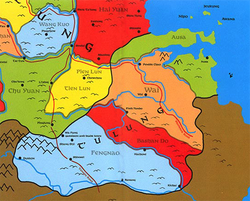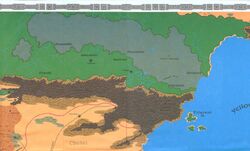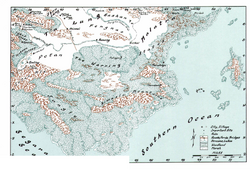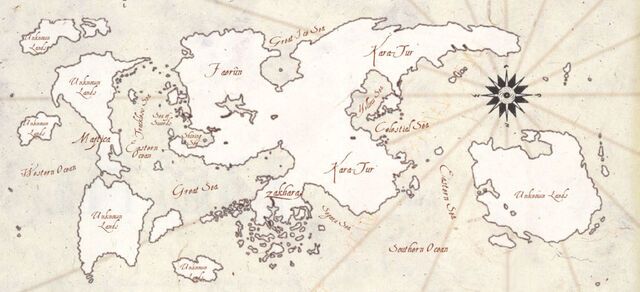Kara-Tur (pronounced: /kɑːrɑːˈtoʊɜːr/ kah-rah-TOUR[1]) was a continent lying east of Faerûn on Toril. Between Kara-Tur and Faerûn stretched the Hordelands for hundreds of miles.[2]
Trade, people, and items occasionally arrived in Faerûn from Kara-Tur via the Golden Way, but beyond that there was little interaction between the continents.[citation needed]
Countries
The various countries of Kara-Tur included the following.
Shou Lung
A map of Shou Lung.
Shou Lung was arguably the most powerful nation on Toril.[citation needed]
The empire was started by a simple peasant known as Nung Fu, who was invested with the Emblems of Imperial Authority by the semi-legendary Nine Travelers (although it was his great grandson that would be the first Emperor of the Li Dynasty). The Empire of Shou Lung had the longest history in Kara-Tur, second only to the empire of Wa.[citation needed]
The official head of the government was the Emperor, but in practice everyday affairs of state were handled by the Chancellor, who executed the Emperor's decrees, oversaw the bureaucracy, and controled the information that reached the emperor's ears. In the mid–1300s DR, the Emperor was Kai Tsao Shou Chin. The wu jens were the Emperor's official court wizards, who advised the Emperor's policies with divinations and dealt with magical threats. The government was composed of eight ministries: State, War, Magic, Faith, Sea, Agriculture, Public Works, and State Security. It was a meritocratic system; every year the Civil Service Examination held examinations to test candidates for government jobs.[citation needed]
The Shou always had a strong trading relationship with Faerûn. In fact, certain regions in Faerûn made a living solely on the imports from Shou Lung and many merchants, settlers, and diplomats have come to Faerûn in search of new opportunities in the west. The people of Shou Lung frowned upon the slave trade, and anybody found guilty of trafficking in slaves was put to death.[citation needed]
The Shou practiced mainly two forms of religion, the Path of Enlightenment and the Way. The majority of the people in Shou Lung practiced the Path of Enlightenment, in which they worshiped the Celestial Emperor and the Nine Travelers and a whole host of lesser immortals and spirits who make up what was called the Celestial Bureaucracy. Unlike the people of Faerûn, devotion to a single deity was very rare in Shou Lung. The other Shou religion, was simply called the Way and was more of an ethical philosophy than a true religion characterized by divinities, spirits, and a fully realized metaphysics. It focused on the enlightenment of the self through the practice of certain spiritual exercises rather than the worship of particular gods.[citation needed]
Lying between Kara-Tur and the Plain of Horses was a great stone wall known as the Dragonwall. According to legend, a wu jen wizard was tasked by the emperor with finding a way to keep the Tuigan hordes from raiding Shou Lung's northern provinces. The wu jen stole the Jade Mirror from the sea dragon Pao Hu Jen, whose body was thousands of kilometers long. The wu jen led the dragon on a chase along the border, and at a certain point stopped and held up the Jade Mirror to the dragon's eyes, which instantly turned him to stone. After his petrified body fell to the ground, the emperor had his engineers carve fortifications into it so that it could serve them as a defensive wall.[citation needed]
Places of interest included the port of Karatin, capital of the Hai Yuan, or Maritime provinces, and the Kao Shan province with the semi-independent city of Kai Shan. The main criminal organization in the country was the Tsui Tong.[citation needed]
T'u Lung

A map of T'u Lung.
T'u Lung used to be the southern part of the Shou Lung empire, before it broke away in civil war.[citation needed]
Tabot

A map of Tabot.
The nation of Tabot was formed during the "Year of Frost" when the Shou Ho Dynasty decreed that the Path of Enlightenment was to be the official and only religion in Shou Lung. Many monks, temples, and religious orders of the Way were persecuted in Shou Lung and they fled to the mountains. The temple militias of sohei and monks that fled there formed an alliance against the Shou and founded the nation of Tabot. The Shou attempted invasions well into the early Kai Dynasty but had little success due to the Crystalline Warriors of Ji that protected Tabot. Centuries later, the nobles of Tabot were overthrown by a six-year-old boy called the High Lord of Oceans, and established Tabot's current theocratic government in which the clergy of the Way hold the most political power in the mountainous nation.[citation needed]
Plain of Horses
A map of the Plain of Horses.
The barbarians of the Plain of Horses have tried countless times to invade their neighbors, Shou Lung and T'u Lung, and were successful on a few occasions, but their victories were often short lived. In 1359 DR, Tuigan tribes successfully breached the Dragonwall and devastated many of the northwestern provinces of the Shou Empire. During this invasion, many Shou refugees fled to Faerûn and settled in the Thesk region of the Unapproachable East. The Horde tribes were eventually driven out and Shou Lung and T'u Lung focused most of their military prowess towards defending against further invasions.[citation needed]
Northern Wastes

A map of the Northern Wastes.
The Northern Wastes was actually a very diverse and interesting part of Kara-Tur, but more was known of its southern regions than of the northern regions. The southern lands were called the Ama Basin in honor of the Ama River flowing through them. There was also a large massif called the Koryaz Mountains and plenty of swamps and forests. There were several native tribes, such as the Issacortae, Pazruki, and the Wu-haltai. They differed from each other in culture and custom. This land was home to many immigrants hailing from the Plain of Horses and elsewhere. Many less developed races, like the korobokuru, called the Northern Wastes their home. Their tribes tended to be at the lowest level of development, often using stone or bronze tools and weapons. Since most of the peoples of the Northern Wastes had no written language, there was little to no written history on them.[citation needed]
Malatra

A map of Malatra.
Malatra was a land predominantly covered in jungle south of T'u Lung. Three nation states claimed parts of these lands and were quite different from each other and from the rest of Kara-Tur: Purang, Laothan, and the Kuong Kingdom. Territorial boundaries in these lands were largely irrelevant and many hapless adventurers and merchants met their deaths exploring the wild rainforests. In the dense jungles, swamps, and misty mountains, terrible creatures and native wild tribes that did not know the meaning of mercy could be found. In these lands, even experienced locals did not go far from the towns and cities, and none were aware of what was happening in the heart of these wild lands, which were protected by ancient and powerful magic as well as nigh-impassable terrain and dinosaurs.[citation needed]
Island Kingdoms
Koryo

A map of Koryo.
Kozakura
Kozakura was an archipelago nation found several hundred miles to the east of Shou Lung, and to the south of Koryo. In the mid-1300s DR, the head of government was the shikken, Tanekawa Okawa, a regent for the seventeen-year-old shogun. In theory, he ran a feudal society, but outside of the capital his power was mostly symbolic. The largest island, Shinkoku, was roughly in the center of the archipelago, and was also home to the imperial capital, Doiyu.[citation needed]
Wa
Appendix

|
This page uses content from Wikipedia. The original article was at Kara-Tur. The list of authors can be seen in the page history. As with Forgotten Realms Wiki, the text of Wikipedia is available under the Creative Commons Attribution-ShareAlike 3.0 License. Additional terms may apply. See Wikia licensing policy and Wikimedia projects Terms of Use for further details. |
| This article is incomplete. You can help the Forgotten Realms Wiki by providing more information. |
Background
Kara-Tur is a fantasy world created by Gary Gygax, David "Zeb" Cook, and François Marcela-Froideval and detailed in 1985's Oriental Adventures for the 1st-edition Advanced Dungeons & Dragons role-playing game. Kara-Tur roughly corresponds to ancient East Asia in the real world, and many countries, places, and peoples can find common ground with real-life examples.
Originally intended as a western part of the continent of Oerik, it was first released as a stand-alone campaign setting, and by 1988 it was combined by TSR, Inc. with the Forgotten Realms campaign setting, being placed on the planet Toril, lying east of Faerûn. In that year TSR released a boxed set with two books detailing the campaign setting and maps, Kara-Tur: The Eastern Realms.
In 1989, a printing of Kara-Tur Trail Map appeared.
In 1990, the maps of Kara-Tur were included in The Forgotten Realms Atlas. Later that year, TSR gave the monsters for Kara-Tur a proper treatment for 2nd-edition Advanced Dungeons & Dragons in the Monstrous Compendium series.
After 1990, Kara-Tur was a mostly discarded campaign setting, with only a few mentions in cross-over products such as Spelljammer and Ravenloft, plus a few mentions in other Forgotten Realms products and Dragon Magazine articles.
With the release of 3rd-edition Dungeons & Dragons with new owners, Wizards of the Coast decided to do a proper treatment for Oriental Adventures. All the character classes, monsters, spells, weapons, and feats were converted to 3rd-edition rules, but this time with the campaign world being Rokugan, the setting for Alderac Entertainment Group's Legend of the Five Rings.
The setting of Kara-Tur still existed on Toril and was often mentioned. Characters and artifacts from Kara-Tur sometimes showed up in Faerûn-set sources, but beyond that there was little exploration of the continents bar some Dragon magazine articles.
References
- ↑ Ed Greenwood, Julia Martin, Jeff Grubb (1993). Forgotten Realms Campaign Setting 2nd edition (revised), A Grand Tour of the Realms. (TSR, Inc), p. 5. ISBN 1-5607-6617-4.
- ↑ Ed Greenwood, Sean K. Reynolds, Skip Williams, Rob Heinsoo (June 2001). Forgotten Realms Campaign Setting 3rd edition. (Wizards of the Coast), p. 230. ISBN 0-7869-1836-5.
Official Material
- List of source material on Kara-Tur
- The Assam Portal
- Harmun Righthand
- Room 13: Ogre Trouble (features Tharrusk, an ogre mage from Kara-Tur)
Connections
Landmasses: Anchorome • Evermeet • Faerûn • Kara-Tur • Katashaka • Laerakond • Maztica • Merrouroboros • Osse • Zakhara
Seas and Oceans: Celestial Sea • Eastern Ocean • Eastern Sea • Great Ice Sea • Great Sea • Sea of Fallen Stars • Sea of Swords • Segara Sea • Shining Sea • Silver Sea • Southern Ocean • Trackless Sea • Western Ocean • Yellow Sea
The Nine Immortals
Ai Ch'ing • Chan Cheng • Ch'en Hsiang • Chih Shih • Fa Kuan • Hsing Yong • Kwan Ying • Nung Chiang • Shu Chia
The Lesser Immortals
Jade Ladies • Ladies of Compassion • Lords of Karma • Monkey • Moon Women • Rice Spirits • Spirit Warriors
The Sages • Ancestors • Spirits


